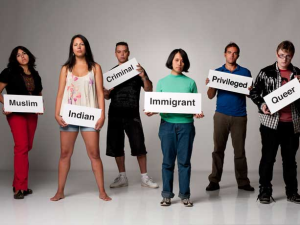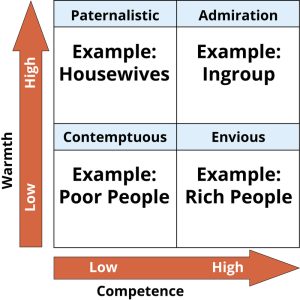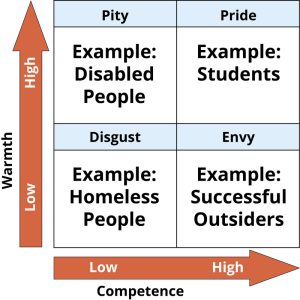8 Prejudice, Discrimination, and Stereotyping
People are often biased against others outside of their own social group, showing prejudice (emotional bias), stereotypes (cognitive bias), and discrimination (behavioral bias). Biases can explicit (overt and conscious) or more implicit (automatic, ambiguous, and ambivalent). In the 21st century, however, with social group categories even more complex, biases may be transforming.
Learning Objectives
- Distinguish prejudice, stereotypes, and discrimination.
- Distinguish blatant biases from subtle biases.
- Understand biases such as social dominance orientation and right-wing authoritarianism.
- Understand subtle, unexamined biases that are automatic, ambiguous, and ambivalent.
- Understand 21st century biases that may break down as identities get more complicated.
Introduction
We commonly say that we “should not label” others but we cannot help but do so. We categorize people according to their citizenship, gender, allegiance to a sports team, and university affiliation, among other qualities. Although categorizing can be useful, it can also result in serious and negative consequences when labels are associated with a person or group’s worth. This module focuses on biases against individuals based on group membership and against groups.

From Category to Combative
People naturally create mental categories. We group household objects together as “furniture,” certain domestic animals as “pets,” and certain books as “classics.” Categories are helpful because they provide a mental roadmap for how to interact in novel situations. For example, a person might not have ever been to a Hindu wedding, but their experience of “weddings” as a general category can help them know what to expect and how to behave. Weddings are generally happy occasions (it is more appropriate to say “congratulations” than “I am so sorry”), they are formal affairs (people typically dress up), and they usually include food (you don’t need to stop and eat before attending the wedding).
Categories get more complicated when we apply them to humans. We naturally categorize people by age, language, occupation, ethnicity, income, and many other qualities. In the abstract these mental maps can help us understand how to interact with new people based on educated guesses about their category. Unfortunately, problems can also arise from our tendency to categorize.
First, there is the problem of stereotyping. Stereotypes are biased thoughts about a person due to the incorrect belief that the category accurately describes them. For instance, Margaret might not be “typical” (or stereotypical) of an 80-year-old in that she regularly competes in organized half-marathons. She goes against the common idea of older adults as being weak or unhealthy.
Next, categorization can also lead to prejudice. Like stereotypes, prejudice is a bias against people based on their group membership. Where stereotypes are related to thinking, prejudices are more emotional in nature. If people hold a negative view of Margaret because they hold negative views about older adults in general, this is prejudice.
Finally, the tendency to categorize can be associated with discrimination. Discrimination is a behavior bias against a person (or group) based on stereotyped beliefs about that group. If people do not want to invite Margaret on vacation because they fear that she will move too slowly (a common view of older people) then they are discriminating against her.
Historical Biases
Today, many nations have equality clearly articulated in their constitutions. Iceland, for example, guarantees legal equality between men and women. Similarly, Ecuador guarantees the fundamental right to sexual orientation and gender identity. Unfortunately, even when some countries have created legal protections, they thought that “equality” applied to only select groups. For instance, the constitution of the United States attempted to ensure that all people were represented by the government and could participate in the creation of government. At the time it was written, however, women and minorities (especially enslaved people) were not included in this sentiment. How is it that entire groups of people were left out of political participation, justice, and freedom?
One explanation is that historical biases were widespread and institutionalized. It was considered acceptable to openly disparage entire groups of people and to pass laws that restricted or harmed these groups. Just 80 years ago, American college students unabashedly thought Turkish people were “cruel, very religious, and treacherous” (Katz & Braly, 1933). These types of stereotypes were overt, unapologetic, and expected to be shared by others—what we now call “blatant biases.” They were generalizations about a group, since most of the college students did not interact with people from Turkey.
Blatant biases (also called “explicit biases”) are conscious beliefs, feelings, and behavior that people are perfectly willing to admit, which express hostility toward other groups (outgroups) while unduly favoring one’s own group (in-group). Classic examples of blatant bias include the views of members of hate groups such as the Ku Klux Klan and members of Hitler’s Nazi party.
Blatant bias is not a thing of the past, however. People have always and still do openly dehumanize outgroup members and harbor hostile attitudes toward them. That said, the targets of bias sometimes shift across time. In the United States, for instance, waves of new immigrants such as Chinese people, Irish people, and Italians, were met with open hostility, with attitudes often shifting to the most recent group of immigrants. More recently, during the COVID-19 pandemic, some people held hostile views of Asian-Americans, who they perceived as being associated with the coronavirus (Misra, Le, Goldmann & Yang, 2020).
These blatant biases tend to run in packs: People who openly hate one outgroup also hate many others. To illustrate this pattern, we turn to two ideologies related to bias.
What are Biased People Thinking?
Social Dominance Orientation

Social dominance orientation (SDO) describes a belief that group hierarchies are inevitable in all societies and are even a good idea to maintain order and stability (Sidanius & Pratto, 1999). People who score high on SDO believe that some groups are inherently better than others, and because of this, there is no such thing as group “equality.” At the same time, though, SDO is not just about being personally dominant and controlling of others; SDO describes a preferred arrangement of groups with some on top (preferably one’s own group) and some on the bottom. For example, someone high in SDO would likely be upset if someone from an outgroup moved into her neighborhood. It’s not that the person high in SDO wants to “control” what this outgroup member does; it’s that moving into this “nice neighborhood” disrupts the social hierarchy the person high in SDO believes in (i.e. living in a nice neighborhood denotes one’s place in the social hierarchy—a place reserved for one’s in-group members).
Although research has shown that people higher in SDO are more likely to be politically conservative, there are other traits that more strongly predict one’s SDO. For example, researchers have found that those who score higher on SDO are usually lower than average on tolerance, empathy, altruism, and community orientation. In general, those high in SDO have a strong belief in work ethic—that hard work always pays off and leisure is a waste of time. People higher on SDO tend to choose and thrive in occupations that maintain existing group hierarchies (police, prosecutors, business), compared to those lower in SDO, who tend to pick more equalizing occupations (social work, public defense, psychology).
The point is that SDO—a preference for inequality as normal and natural—also predicts endorsing the superiority of certain groups: men, native-born residents, heterosexuals, and believers in the dominant religion. This means seeing women, minorities, homosexuals, and non-believers as inferior. Understandably, people from the first list of groups tends to score higher on SDO, while those from the second group tend to score lower. For example, the SDO gender difference (men higher, women lower) appears all over the world. At its heart, SDO rests on a fundamental belief that the world is tough and competitive with only a limited number of resources. Thus, those high in SDO see groups as battling each other for these resources, with winners at the top of the social hierarchy and losers at the bottom (see Table 8-1).

Right-wing Authoritarianism
Right-wing authoritarianism (RWA) is an ideology that emphasizes conformity or obedience to authority (Altemeyer, 1988). Whereas SDO emphasizes potential economic conflicts, RWA focuses on value conflicts. Returning to an example from earlier, the homeowner high in SDO may dislike the outgroup member moving into her neighborhood because it “threatens” one’s economic resources (e.g. lowering the value of one’s house; fewer openings in the school; etc.). By contrast, those high in RWA may equally dislike the outgroup member moving into the neighborhood but for different reasons. Here, it is because this outgroup member brings in values or beliefs that the person high in RWA disagrees with, thus “threatening” the collective values of his or her group. RWA respects group unity over individual preferences, wanting to maintain group values in the face of differing opinions. Calls for national unity and patriotism that do not tolerate dissenting voices are an example.
Despite its name, though, RWA is not necessarily limited to people on the right (conservatives). Like SDO, there does appear to be an association between this ideology (i.e. the preference for order, clarity, and conventional values) and conservative beliefs. However, regardless of political ideology, RWA focuses on competing frameworks of values. This means, potentially, that there is left-wing authoritarianism that promotes conventional progressive values and seeks to silence dissenting voices (Manson, 2020). Notably, the combination of high RWA and high SDO predicts joining hate groups that openly endorse aggression against minority groups, immigrants, homosexuals, and believers in non-dominant religions (Altemeyer, 2004).
Implicit Biases
Today, there is a greater appreciation of the fact that not all biases are overt hostility based on a personal animosity toward members of a group. Subtle biases (also called “automatic” or “implicit” biases) are unexamined and sometimes unconscious, but just as real in their consequences. They are automatic, ambiguous, and ambivalent, but nonetheless biased, unfair, and disrespectful to a belief in equality.
Automatic Biases
Most people have a positive view of themselves. They believe they have good values, rational thoughts, and strengths. Most people also identify as members of certain groups but not others. They are Canadian, or fans of Manchester United, or are doctors. Logic suggests, then, that because we like ourselves, we also like the groups in which we are members. We might feel affinity toward people from our home town, a connection with those who attend our university, or commiserate with the experience of people who share our gender identity, religion, or ethnicity. Liking yourself and the groups to which you belong is natural. The larger issue, however, is that own-group preference often results in liking other groups less. And whether you recognize this “favoritism” as wrong, this trade-off is relatively automatic (unintended, immediate, and irresistible).
Social psychologists have developed several ways to measure this automatic preference, the most famous being the Implicit Association Test (IAT; Greenwald, Banaji, Rudman, Farnham, Nosek, & Mellott, 2002; Greenwald, McGhee, & Schwartz, 1998). The test itself is rather simple (and you can experience it yourself here). The IAT measures how quickly you can sort words or pictures into different categories. For example, if you were asked to categorize “ice cream” as good or bad, you might quickly categorize it as good. However, imagine if every time you ate ice cream, you got a brain freeze. When it comes time to categorize ice cream as good or bad, you may still categorize it as “good,” but you will likely be a little slower—perhaps even fractions of a second slower– in arriving at this judgment. This is how the IAT works: measuring tiny differences in the time it takes you to make judgments.
This is an especially useful way to measure potential biases because it does not simply ask people to openly report on the extent to which they discriminate against others. Instead, it measures how quickly people make judgments about the goodness or badness of various groups. The IAT is sensitive to very slight hesitations that result from having automatic or unconscious biases. People are generally faster at pairing their own group with “good” categories. In fact, this finding generally holds regardless of whether one’s group is measured according race, age, religion, nationality, and even temporary, insignificant memberships.
It might be easy to dismiss the IAT findings of the all-too-human tendency toward faster, more favorable processing of one’s own group. It turns out, however, that people’s reaction time on the IAT predicts actual feelings about out-group members, decisions about them, and behavior toward them, especially nonverbal behavior (Greenwald, Poehlman, Uhlmann, & Banaji, 2009).

For example, a job interviewer might have two qualified applicants; a man and a woman. Although the interviewer may not be “blatantly biased,” their “automatic or implicit biases” may be harmful to one of the applicants. For example, the interviewer might hold a negative view of women and, without even realizing it, act distant and withdrawn while interviewing the female candidate. This sends subtle cues to the applicant that she is not being taken seriously, is not a good fit for the job, or is not likely to get hired. These small interactions can have devastating effects on the hopeful interviewee’s ability to perform well (Word, Zanna, & Cooper, 1974).
Although this is unfair, sometimes the automatic associations—often driven by society’s stereotypes—trump our own explicit values (Devine, 1989). Sadly, this can result in consequential discrimination, such as allocating fewer resources to disliked outgroups (Rudman & Ashmore, 2007).
Ambiguous Biases

The results from research using the IAT are consistent with social identity theory. Social identity theory (Tajfel, Billig, Bundy, & Flament, 1971) describes this tendency to favor one’s own in-group over another’s outgroup. As a result, outgroup disliking stems from this in-group liking (Brewer & Brown, 1998). For example, if two classes of children want to play on the same soccer field, the classes will come to dislike each other not because of any real, objectionable traits about the other group. The dislike originates from each class’s favoritism toward itself and the fact that only one group can play on the soccer field at a time. With this preferential perspective for one’s own group, people are not punishing the other one so much as neglecting it in favor of their own. In our soccer example, one set of children will focus on their own desire to play without really regarding the similar desire of the other class as equal and legitimate. However, to justify preferential treatment, people often exaggerate the differences between their in-group and an outgroup. Specifically, people see members of an outgroup as more similar to one another in personality than they actually are. The result is seeing people who live in subsidized housing, or who like comic books, or who are religious, or who have autism as one homogenous group with little variation.
Spontaneously, people categorize people into groups just as we categorize furniture or food into one type or another. The difference is that we categories ourselves, as self-categorization theory points out (Turner, 1975). Because the attributes of group categories can be either good or bad, we tend to favor the groups with people like us and incidentally disfavor the others. In-group favoritism is an ambiguous form of bias because it disfavors the outgroup by exclusion. For example, authoritarian leaders tend to allocate more national resources to members of their own tribe, religious sect, or political party.
A specific case of comfort with the ingroup is called aversive racism, so-called because people do not like to admit their own racial biases to themselves or others (Dovidio & Gaertner, 2010). Tensions between, say, a White person’s own good intentions, on the one hand, and discomfort with closely interacting with a Black person, on the other hand, may cause the White person to behave stiffly or be distracted. As a result, the White person may give a good excuse to avoid such awkward situations. Such a reaction will be ambiguous to both parties and difficult to interpret. Was the White person right to avoid the situation so that neither person would feel uncomfortable? Was the White person wrong because they will never learn to be comfortable if they avoid contact? Indicators of aversive racism correlate with discriminatory behavior, despite being the ambiguous result of good intentions gone bad.
Ambivalent Biases
Not all stereotypes of outgroups are all bad. For example, ethnic Asians living in the United States are commonly referred to as the model minority because of their perceived success in areas such as education, income, and social stability. Another example includes people who feel benevolent toward traditional women but hostile toward nontraditional women. Or even ageist people who feel fond of older adults but, at the same time, view them as incompetent to support themselves and worry about the burden they place on public welfare programs. A simple way to understand these mixed feelings, across a variety of groups, results from the Stereotype Content Model shows that social groups are viewed according to their perceived warmth and competence. (Fiske, Cuddy, & Glick, 2007).
The stereotype content model attends to two major dimensions of evaluating other people: warmth and competence. First, people are interested in understanding the intentions of others. Like the guard at night saying: “Who goes there, friend or foe?” If the other group has good, cooperative intentions, we view them as “warm” and often consider them part of “our side.” However, if the other group is “cold,” we often view them as a threat and treat them accordingly. We also want to know whether the members of the group are competent enough to act on their good or ill intentions. These two simple dimensions—warmth and competence—together map how groups relate to each other in society.

Common stereotypes of people from all sorts of categories and occupations turn out to classify them along these two dimensions (see Figure 8-1). For example, the ingroup in most societies is the average citizen, seen as warm and competent. At another end of the spectrum are homeless people and drug addicts, stereotyped as not having good intentions (perhaps untrustworthy) and likewise being incompetent (unable) to do anything useful. Some group stereotypes are mixed, high on one dimension and low on the other. For example, rich people are often viewed as competent but cold. And a stereotypical “old person” would be seen as high in warmth but lower in competence. This is not to suggest that actual older people are not competent, of course, but that they are not widely admired for their accumulated wisdom.
A group’s position on the dimensions of warmth and competence dictate whether we relate to its members with admiration, dehumanizing contempt, competitive envy, or paternalistic caretaking. These four kinds of stereotypes and their associated emotional prejudices (see Figure 8-2) occur all over the world and apply to each society’s own groups. These maps of the group terrain predict specific types of discrimination for specific kinds of groups.

Conclusion: Today’s Prejudices
As the world becomes more interconnected—more collaborations between countries, more intermarrying between different groups—more and more people are encountering greater diversity of others in everyday life. Just ask yourself if you’ve ever been asked, “What are you?” This question is frequently asked to people about their ethnicity, national origin, gender identity, religion, and other group affiliations. Such a question would be preposterous if you were only surrounded by members of your own group. Categories, then, are becoming more and more uncertain, unclear, volatile, and complex (Bodenhausen & Peery, 2009). People’s identities are multifaceted, intersecting across gender, race, class, age, region, and more. Identities are not so simple, but maybe as the 21st century unfurls, we will recognize each other by the content of our individual character instead of against the backdrop of stereotypes.
Text Attribution
Media Attributions
- Found a bunch of stormtroopers in…
- Occupy San Francisco
- Table 8.1
- Table 8.2
- Headlines Theatre- Us and Them
- Figure 8.1
- Figure 8.2
Our general beliefs about the traits or behaviors shared by group of people.
An evaluation or emotion toward people based merely on their group membership.
Discrimination is behavior that advantages or disadvantages people merely based on their group membership.
Blatant biases are conscious beliefs, feelings, and behavior that people are perfectly willing to admit, are mostly hostile, and openly favor their own group.
Social dominance orientation describes a belief that group hierarchies are inevitable in all societies and even good, to maintain order and stability.
Right-wing authoritarianism focuses on value conflicts but endorses respect for obedience and authority in the service of group conformity.
Subtle biases are automatic, ambiguous, and ambivalent, but real in their consequences.
A behavior or process has one or more of the following features: unintentional, uncontrollable, occurring outside of conscious awareness, and cognitively efficient.
An implicit attitude task that assesses a person’s automatic associations between concepts by measuring the response times in pairing the concepts.
Social identity theory notes that people categorize each other into groups, favoring their own group.
Self-categorization theory develops social identity theory’s point that people categorize themselves, along with each other into groups, favoring their own group.
Aversive racism is unexamined racial bias that the person does not intend and would reject, but that avoids inter-racial contact.
A minority group whose members are perceived as achieving a higher degree of socioeconomic success than the population average.
Stereotype Content Model shows that social groups are viewed according to their perceived warmth and competence.

